Students
- Amy Saraya
- Xu Minjie
Professor
- Yusuke Obuchi
Course Assistants
- Toshikatsu Kiuchi
Used coffee grounds are collected from Tokyo’s coffee shops. The grounds are aggregated and solidified into components before being used as odor-absorbing architecture to transform alleyways.
使用済みのコーヒーかすを、東京のコーヒーショップから収集します。コーヒーかすは硬化してコンポーネントとし、匂いを吸収する建築として路地空間に使用します。
Used coffee grounds are the raw material for the proposal. There are many coffee shops in Tokyo, and these grounds could be aggregated on an urban scale to produce a new resource.
使用済みコーヒーかすを原料とします。東京には多くのコーヒーショップがあるため、これらのかすを都市スケールで集積し、新しい資源とします。
The coffee grounds, when collected, are solidified and created into a component. The components are organized together into box-like formations to create architecture.
コーヒーかすは集められた後、硬化させ、コンポーネントになります。コンポーネントは、建築を形成するために、箱状に積み上げられます。
The architecture creates a unique gathering space that intends to transform Tokyo’s alleyways.
この建築は、東京の路地を有効に活用するためのユニークな集いの空間を生み出します。
The architecture, in addition to being visually interesting, is also odor-absorbing due to the coffee content of the proposal. This aids in creating a more pleasant experience in alleys.
この建築は、視覚的に興味深いだけでなく、コーヒーかす素材によって匂いを吸収します。このことは、路地での経験をより気持が良いものにするのに役立ちます。



Students
- Kevin Clement
- Anders Rod
Professor
- Yusuke OBUCHI
Course Assistants
- Toshikatsu KIUCHI
Waste food at convenience stores is collected and transformed into a bioplastic material. This bioplastic can be used to create architecture.
コンビニエンスストアで廃棄食品を収集し、バイオ・プラスチック素材として再利用します。このバイオ・プラスチックを建築で使用します。
Waste food collected from convenience stores is collected. A large amount of food is wasted every day at Tokyo convenience stores and the waste has potential as a resource.
コンビニエンスストアから集めた廃棄食品を活用します。毎日、多量の食糧が東京のコンビニから廃棄されており、資源としての可能性があります。
The material is transformed into a bioplastic which hardens after a period of time.
材料は、一定の時間が経つと硬化するバイオ・プラスチックに変換されます。
The bioplastic is used with a 3D drawing pen and architecture can be “drawn” by a user.
バイオ・プラスチックは、 3 D描画ペンによって用いられ、ユーザーが建築を「描く」ことができます。
The project proposes a use for waste food and in creating the temporary architecture, produces a community gathering space.
このプロジェクトは、食品廃棄物の再利用した仮説建築によって、近隣コミュニティーの人々が集まることのできるスペースを提供します。



Students
- Benjamin Berwick
- Yanli Xiong
Professor
- Yusuke Obuchi
Course Assistants
- Toshikatsu Kiuchi
Hair is collected from Tokyo hair salons. The material is gathered and punched to produce components, and is then assembled to create an adaptive shade for apartments.
毛髪を東京の美容院から収集します。毛髪を圧縮してコンポーネントを形成し、集合住宅に適応する日除けをつくります。
The raw material for the project is hair collected from Tokyo hair salons. The clippings are usually thrown away, but on the urban scale and through aggregation, the hair is a potential resource.
プロジェクトの原料は、東京の美容院から収集した毛髪です。切り刻まれた毛髪は通常廃棄されますが、都市的な規模で集約することにより、資源となる可能性があります。
The hair is punched to create a fabric-like material after it is aggregated. Components can then be created from the material in a folding pattern.
毛髪は、生地のような素材に変換するため圧縮されます。出来上がったコンポーネントで、折り畳みパターンをつくります。
A series of folded components are fit together to produce a canopy which can be moved and repositioned as the user sees fit.
一連の折り畳みコンポーネントは、寄り集まって可動の日除けになります。ユーザーは、ふさわしい位置にそれを動かすことができます。
The canopy provides shade, but it also allows the owner of the canopy to personalize the façade of their balcony (upon which the canopy is placed).
日除けを動かすことによって、所有者は、集合住宅のファサードをカスタマイズすることができます。






